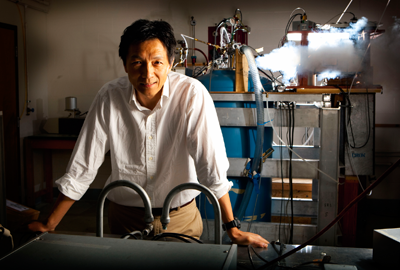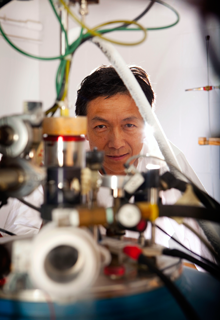by Robin Roenker
photos by Mark Cornelison

The transistor is perhaps the most prolific and highly successful example of electronic material in action. It’s the fundamental building block of today’s electronic devices—from cell phones to iPods to personal computers.
Some have called the transistor the greatest invention of the 20th century. Its development and perfection over the last 60 years has largely been a result of the research and development work of condensed matter physicists—scientists who study the fundamental properties of solids and liquids. Their work to create and study new electronic and magnetic materials has yielded “the largest number of practical applications” of any subfield of physics, according to physics professor Gang Cao, who joined UK’s Department of Physics and Astronomy in 2002.
Cao also points out that it is widely recognized that whoever discovers and controls the optimized synthesis of novel materials generally controls the investigation of their often unique properties and, ultimately, their successful integration into advanced technologies.
And what is to be the field’s greatest contribution to the 21st century? Cao expects the University of Kentucky’s Center for Advanced Materials at the forefront of charting that answer.
Launched last year thanks to a $4.5 million National Science Foundation EPSCoR (Experimental Program to Stimulate Competitive Research) grant, the center will position the University of Kentucky among the top university labs in the nation doing research in new materials synthesis and characterization, Cao said.
“Ultimately, we want to improve and discover new materials for future application,” he said. “That is our ultimate goal.”
Having worked for 12 years at the National High Magnetic Field Laboratory in Tallahassee, Fla., before coming to UK, Cao, along with many in his field, has noted that U.S. leadership in materials research has seriously eroded in recent years due to a growing shortage of scientists and engineers who possess skills in both the synthesis and characterization of new materials. “The current situation presents an urgent national challenge that could ultimately undermine our economic competitiveness if left unaddressed,” Cao stated.
By launching and directing the new Center for Advanced Materials at UK, he believes the University of Kentucky can establish a unique niche as a specialist in both the development of new materials and the analysis of their particular properties.
To do that, the center will draw on the expertise of UK’s physics faculty already doing work in condensed matter physics—roughly a quarter of the department—as well as cross-disciplinary collaborations with researchers in UK’s chemistry, engineering, and other departments.
The center’s work emphasizes the creation of new materials in both bulk-single-crystal and thin-film forms having unusual electrical transport, magnetic, and optical properties. Once created, the center works to characterize the new materials’ properties at extreme conditions, such as high magnetic fields, ultra low temperatures, and high pressures.
“We have the advantage of an internationally recognized faculty—our human powers—as well as top-notch laboratory capacities to ensure high quality materials in single crystal form. That allows us to study the most intrinsic properties of the materials we produce,” Cao said.
The grant also includes funding for four new faculty positions, three of which have already been filled. And it’s allowing the center to purchase cutting-edge equipment for, including a helium liquefier—a truly coveted asset few universities can boast. The machine will allow UK’s faculty more steady and cost-effective access to the liquid helium they depend on as a cooling agent for their research, eliminating the need to purchase it from an outside source.
 Thanks to his award as a 2009-10 UK Research Professor, Cao will be able to take some time off next year from teaching to focus on the continued establishment and advancement of the center.
Thanks to his award as a 2009-10 UK Research Professor, Cao will be able to take some time off next year from teaching to focus on the continued establishment and advancement of the center.
Cao, a native of Wuhan, China, will also continue his work as chair of the international advisory committee helping oversee the creation of the National High Magnetic Field Center in Hefei, China. The project stems from an effort to enhance Chinese collaborative cooperation with the United States’ National High Magnetic Field Laboratory he began while still working there over 10 years ago.
Graduate students coming to UK will have the benefit of expertise in both materials synthesis and characterization covering a broad spectrum of materials and experimental probes. All students will acquire hands-on experience in specialized investigations of structural and physical properties of materials using state-of-art equipment.
“That is our major focus. We are materials scientists. We have to know how to make materials,” Cao said. “How can you be a capable materials scientist if you don’t know how to make materials?”
“UK is already well positioned in this area,” he stated. “We have created a critical mass to be on top in a few years. There are only a handful of university labs in the country that have the ability to both develop and study new materials with a wide arrange of techniques and probes under one roof. This is going to be our whole advantage.”
